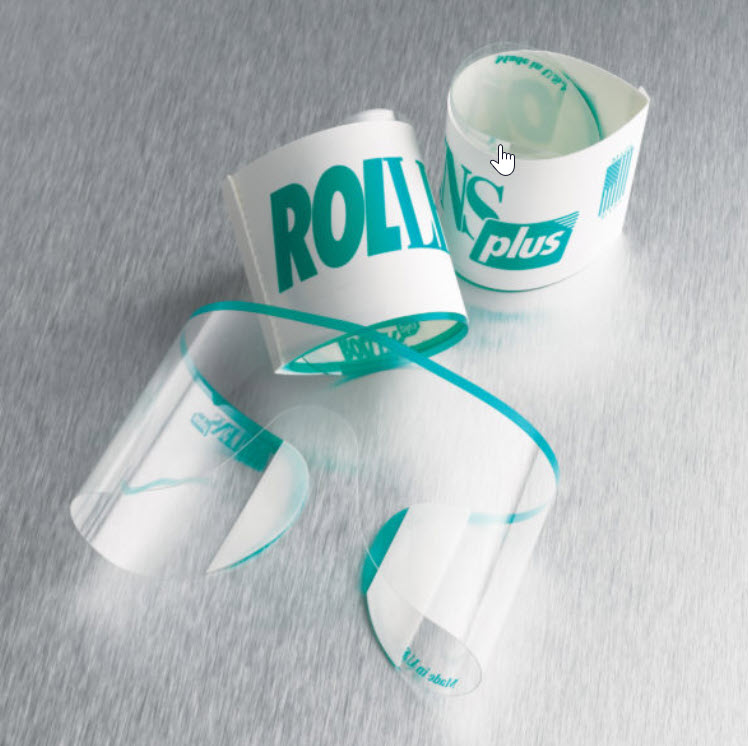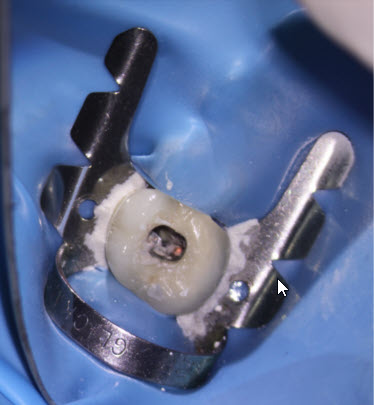Rollens
For patient eye protection, there is no easier/cheaper/better product to use than Rollens. Rollens comes in two versions – Diamond Clear and Diamond Grey. Adhesive tabs on the sides of each disposable Rollens allow for secure fit while protecting the patient against splatter and turbine spray. At the conclusion of the appointment the Rollens is removed and discarded. NO “goggle sanitation measures” are required with this product. The Clear lens give the operator good visibility of the patient’s eyes while the UV protecting Grey version can be used if composite placement with a curing light is anticipated.
This is a great product at a great price! And kids love it so such they sometimes take home their Grey version “Sunglasses”.

Figure 1: Rollens
Diamond Clear with Hypoallergenic adhesive strips

Figure 2: Rollens Diamond Grey
Easy to put on, easy to remove.
Manufacturer
Ultradent
Cost
Check Ultradent website (US) Clinical Research Dental (Canada)
Xylonor Topical – Septodont
We use Xylonor (10% Lidocaine) topical spray (Septodont) before administering any local anesthesia. Many of my patients don’t particularly like the taste of this topical, but I find that that the taste is actually quite a distraction for them, in a positive way. Instead of using chocolate or strawberry flavor, I have found that patients tend to focus on how bad this stuff tastes and, before they know it , the anesthesia has been administered. There so concerned with getting this rinsed out of their mouth that they rarely focus on the anesthetic. The technique has been very good at diverting patient’s attention away from what some dread as an uncomfortable experience, to one which many do not even notice. The only drawback is that occasionally patients may swallow some (as with any topical) and have a “numb” throat that lasts only a few minutes. Onset 2-5mins. Lasts ~10 mins.

Figure 3: Septodont Topical
Topical anesthetic
Ultracaine 4% 1/100,000 epi
I’ve been using Ultracaine (Articaine) 4% 1/100,000 epinephrine for almost 35 years. I am currently using the HANSAmed version. (HANSAmed D S Forte) I use it in all areas of the mouth as my regular anesthetic. I have found it to effective and safe. There has been some controversy in the literature about the use of 4% solutions and paresthesia. I have had no such occurrences in the time I have been using it. When anesthesia is administered properly (which is the responsibility of the clinician), I have found it to be rapid, profound and an excellent part of the endodontic armementarium.
For patients that need to avoid epinephrine, we use Citanest Plain (Prilocaine 4%)
For Endodontic Surgical procedures (where better than normal hemostasis is necessary) we use Xylocaine 2% with 1/50,000 epinephrine.
In cases of severe pain, I will occasionally give an immediate post treatment injection with Marcaine (Bupivicaine) 0.5% 1/20,000 epinephrine, just prior to the patient leaving my office. Several papers over the last 35 years have shown it to be superior to Lidocaine for controlling postop Endodontically related pain as well as having some post anesthesia obtundent properties.
See these articles regarding this topic in the Endo Files cabinet (Anesthesia) section of this site.
Bupivacaine anesthesia–a clinical trial for endodontic therapy. Moore PA, Dunsky JL. Oral Surg Oral Med Oral Pathol. 1983;55:176–9
Building effective strategies for the management of endodontic pain
Keiser and Hargreaves Endodontic Topics Nov 2002 3(1) 93-105

Figure 4: HansaMed D S Forte Ultracaine 4%
4% Articaine with 1/100K Epinephrine
Manufacturer
HANSAmed (Canada) – different maufacturers available
Cost
Check with your local Articaine supplier
Oraseal
Oraseal is the standard caulking material I use to seal rubber dam gaps that may occur around teeth that are being isolated. It is easily applied and removed.

Figure 5: Oraseal
Caulking material – used to seal rubber dam
Manufacturer
Ultradent
Cost
Check Ultradent website (US) Clinical Research Dental (Canada)
Opaldam
In cases where a stiffer material than Oraseal is required to reflect the dam or to anchor a clamp more securely to the tooth, Opaldam, a light cured material, is used to seal the dam and secure the clamp after rubber dam is placed. It can be easily removed post op with the flick of an explorer or plastic instrument. It is also used to isolate teeth during individual external tooth bleaching.

Figure 6: Opaldam
Light cure block out material

Figure 7: Opaldam
Use for protection of gingiva and where a stiffer rubber dam seal is required.
Manufacturer: Ultradent
Cost: Check with Ultradent (direct) or CRD (Canada)
Silker-Glickman Rubber Dam Clamp
The Silker Glickman clamp is an excellent rubber dam clamp to use in situations where molars happen to be the distal abutment of a bridge. The extended wings of the clamp retracts the dam in the area mesial to the tooth being clamped. This can be very handy when fixed prosthetics (or pontics) make it impossible to floss through adjacent teeth . It keeps the adjacent rubber dam from falling back over into the treated tooth area and eliminates the need to ligate the dam under the fixed prosthetics. When used in combination with such products such as Oraseal or Opaldam, excellent rubber dam isolation can be achieved even with complex adjacent prosthetics. I don’t use it all that often, but I found it to be extremely helpful when such a situation arises.

Figure 8 : Silker Glickman Clamp



Figure 2 : Silker Glickman Clamp in use on Distal Molar abutment in above case
Manufacturer
Available directly from Dr. Silker or your Dental Supplier
Website
Cost $15 US
Cling2 and Cling2 Clear Bond Temporary Cement
These are our standard cements used to recement restorations temporarily to teeth. I was introduced to the “Clear” version by a local Prosthdontist. Fast set, easy to remove.

Figure 9: Cling2 Temp cement
Our standard temp cement
Manufacturer
Clinician’s Choice
Website
Cost
Check with local Supplier. Available from Schein in US and CRD in Canada
